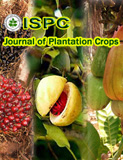Determinants of R & R programme Participation among Coconut Producers in Tamil Nadu: A Heckman Two Stage Selection Approach
DOI:
https://doi.org/10.25081/jpc.2024.v52.i1.9175Abstract
The purpose of the study is to investigate the variables that affect coconut farmers' participation in Tamil Nadu's Replanting and Rejuvenation (R & R) scheme. Utilising a multi-stage sampling technique, a total of 120 coconut farmers were surveyed as respondents. Heckman's two-stage model was used with Probit model included in the first stage, and OLS was used to analyse the income regression in the second stage. Results reveal that age of farmer, education, farming experience, awareness of R&R programme, age of coconut tree, high incidence of pest and diseases, availability of irrigation facilities, and availability of credit for purchasing farm inputs are the most important determining factors for participation. These findings suggest that the R&R program requires to be implemented on a large scale with the aid of Coconut Development Board. This program should focus on removing old, senile, unproductive, and disease-advanced palm trees, replanting them with quality seedlings at subsidized prices, and revitalizing existing gardens through an integrated set of practices.
Downloads
References
Amfo, B. and Ali, E.B. 2020. "Climate change coping and adaptation strategies: how do cocoa farmers in Ghana diversify farm income?", Forest Policy and Economics,119 (1):102265.
Bhovi, A. and Savadatti, P.M. 2017. Growth and Instability Analysis of Coconut Area, Production and Productivity in Karnataka State. Agricultural Situation of India73(11): 11-17.
Greene, WH. 2008. Econometric Analysis. 6th edition ed. New Jersey, USA: Pearson Prentice Hall.
Heckman, JJ. 1976. " The common structure of statistical models of truncation, sample selection and limited dependent variables and a simple estimator for such models.", In Annals of economic and social measurement 5(4):475-492.
Jayasekhar, S. and Jacob, N. 2021. Coconut Sector in India at the crossroads: a brief narrative. Indian Coconut Journal63(12): 12-16.
Kappil, S. R., Aneja, R. and Rani, P. 2021. Decomposing the performance metrics of coconut cultivation in the South Indian States. H u m a n i t i e s S o c i a l S c i e n c e s a n d Communications8(1): 1-8.
Lathika, M. and Ajith Kumar, C.E. 2005. Growth trends in area, production and productivity of coconut in India. Indian Journal of Agricultural Economics60(4): 686-697.
Marchenko, Y. and Genton, M. 2012. "A Hevkman selection model.", Journal of the American Statistical Association107(497):304-317.
Narmadha, N. and Karunakaran, K.R. 2022a. Growth performance of coconut production in Global scenario: A Quin-decadal analysis. Journal of Experimental Agriculture International44(11):7-15.
Narmadha, N. and Karunakaran, K. R. 2022b. A study on trade competitiveness of Indian coconut products. Indian Journal of Economics and Development18(4):868-875.
Thamban, C. Jayasekhar, S. Chandran, K.P. and Jaganathan, D. 2016. Coconut Production in Kerala: Trend, Challenges and Opportunities. Indian Coconut Journal59(8):10-15.
Veerakumaran, G. and Vinaikumar, E. 2019. Problems and prospects of coconut producer organisations in Kerala- An exploratory study. SMART Journal of Business and Management Study15(1):68–73.
Published
How to Cite
Issue
Section
Copyright (c) 2024 Journal of Plantation Crops

This work is licensed under a Creative Commons Attribution 4.0 International License.







 .
.